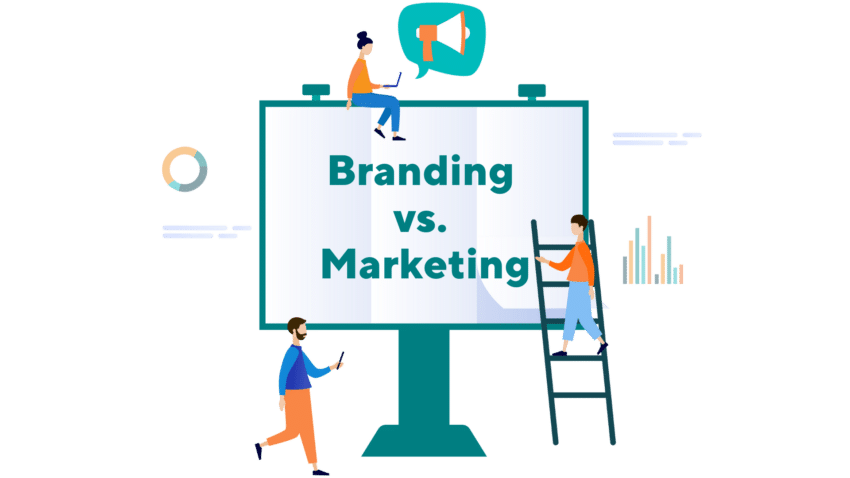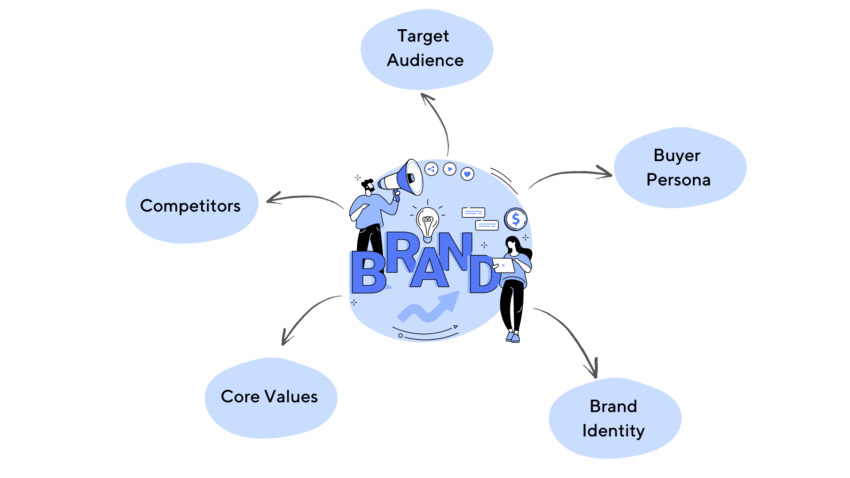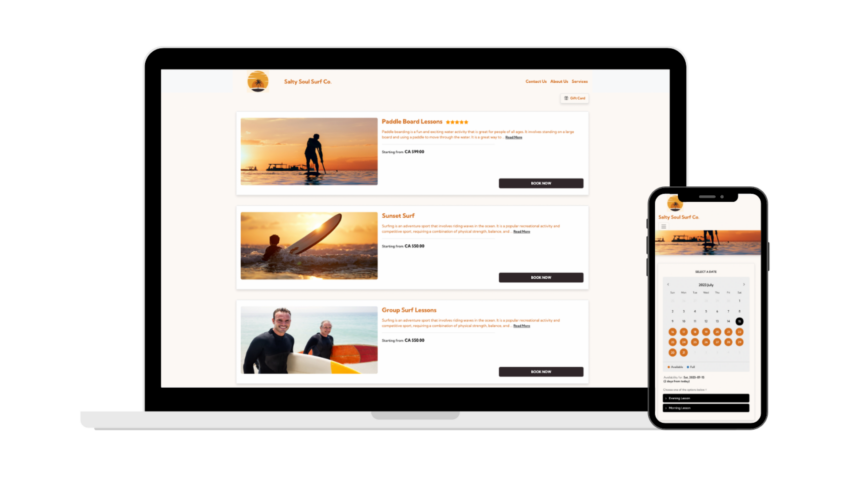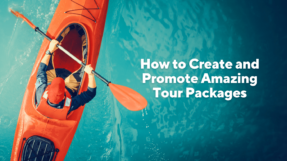Table of Contents
When you run a tour or activity business, it can feel like your to-do list is a million and one items long. Branding and marketing are essential items on that list, but it’s all too common to confuse the two — or worse, ignore one or the other.
While they do overlap, they’re two distinct activities you can do to get more bookings for your business. But what exactly is the difference between branding and marketing? That’s what we’re going to dive into today.
What is Branding?

Branding is how your business is known by your customers. That includes the big questions like your mission, your values, and your unique offerings. But it also includes how you’re recognized, such as your logo, font choices, and colors.
Your branding is even reflected in how you interact with customers on tours, respond to reviews, or write your booking confirmation emails.
In short, branding is who your business is.
With a strong brand identity, your business will stand out from competitors offering similar tours or activities. Customers will recognize your brand, and feel an emotional connection to it and a desire to book. Plus, they’ll — hopefully — develop brand loyalty and book again with you in the future.
What is Marketing?

Marketing is how you get your business in front of would-be customers. It helps you promote your offerings and secure those all-important bookings.
For tour and activity providers, marketing can include running Facebook ads, improving search engine optimization (SEO), posting on social media, or collecting verified reviews.
And while there are endless marketing strategies to try, branding can help you choose the most effective ones. When you know who your business is, you can choose the strategies that will best reach and convert your target audience.
What’s the Difference Between Branding and Marketing?

Marketing and branding are often used interchangeably, but they are two different tools you can use to grow your experience business.
In simple terms, branding is who your business is and marketing is how you promote it. Branding is how you connect with customers and marketing is how you get in front of those customers.
So it shouldn’t be branding versus marketing for tours and activities. For the best results, you need both.
For example, you could have the most unique branding out there, but if nobody knows about your business, it won’t lead to more bookings.
On the other hand, your marketing strategy could drive plenty of potential customers to your website, but if you don’t have a brand identity, they won’t connect with your business or remember you among a sea of competitors. Ultimately, they’ll be less likely to make a booking.
Which Comes First — Branding or Marketing?
Every good marketing campaign is built around a brand’s identity. So branding comes before marketing.
You should ideally develop your branding first, and then use marketing strategies that fit with your brand to get your business in front of the right customers.
When you’ve got a brand identity in place, you’ll know exactly what makes you different from your competitors, and so you’ll know what to highlight in your marketing. You’ll also know exactly who your target customers are, and so the best places to reach them and the best messages to convert them.
Having a brand identity can save you time and money as you can go straight to the marketing activities that will be the most effective for your business. But don’t worry if you’re already marketing without any branding in place. It’s never too late to work on your brand and switch up your marketing activities to match.
How to Improve Your Branding and Marketing Strategy to Drive More Bookings
Now you know the differences between branding and marketing, it’s time to implement some strategies to boost your bottom line. Here’s what to do:
Do Some Brand Brainstorming

When branding your tour or activity business, think about how you want your business to be known and who you want to serve. It can help to create a buyer persona, or a profile of your ideal customer.
To develop a brand identity, ask yourself:
- What experiences do you offer?
- Who is your target audience?
- What makes you different from your competitors?
- What are your core values as a business?
- What is your business’s personality?
- What emotions do you want your customers to feel?
- What do you want customers to think when they hear your business’s name?
When you have an idea of your brand, you can decide on colors, fonts, a logo, and a tone of voice to match.
Next, implement this branding into every part of your business. You want to have a consistent brand identity across your website, social media pages, customer communications, and even offline when customers are in your tour or activity office.
If you have a team, share your brand identity with them and let them know how you’d like this to be reflected in person, over the phone, and in emails with your customers.
Choose Marketing Strategies to Match Your Branding

Once your brand identity is in place, it’s time to consider which marketing strategies you’ll use to promote your business.
The strategies you use may change over time to keep up with trends and changes in the industry, but they should always fit with your branding.
To get started, think about which marketing tactics will best highlight your unique offerings and which will best reach your target audience.
For example, if your customers are 20-something adventure lovers, posting short-form videos of your ziplining routes on TikTok may be the most effective way of capturing their attention.
If your brand identity has a more grown-up feel, creating informative SEO blog posts about the world’s top wine regions may be the best way to increase web traffic and promote your wine-tasting tours.
However you decide to market your experiences, remember that everything you put out into the world should fit with your brand identity. That means every email and social media caption should have a similar tone of voice, and every advertising image should suit your personality.
Get Expert Help From Contractors or Agencies

If you’re in the position to hire some outside help, you can turn to contractors or agencies to outsource some — or all — of your branding and marketing tasks.
Consider your strengths, budget, how much time you have available, and whether any of your staff could help. Then hire experts to fill the knowledge gaps or take some work off your plate.
You can hire an agency to create a brand identity from scratch, or come up with and run entire marketing campaigns. Or you could hire individual contractors to take on smaller aspects of your branding and marketing, such as a freelance writer to create content for your blog or a designer to develop a logo.
If you find your efforts aren’t getting you the search results you need, an SEO firm may also be able to help. Just keep in mind that their goal is to improve your website and content for search — not for your customers. After going to the effort of crafting a thoughtful brand, you’ll want to ensure that any changes you make for search optimization still reflect your brand and connect with your ideal customers.
Doing this all in-house? Check out our guide on building a successful brand on a budget.
Use Rezgo to Make Sure Your Booking Process is On-Brand

Your branding should be consistent across every part of your business — and that includes your booking process.
In fact, consistent branding is even more important when it comes to taking online bookings. You don’t want customers to be surprised by a change in branding, lose trust, and decide to look elsewhere.
For an on-brand booking process, Rezgo offers a white-label booking website you can customize to reflect your brand’s identity. You can link to this booking website from your existing site.
Beyond branding, Rezgo’s online booking website will support your marketing efforts, too, as it’s both SEO and mobile friendly. So wherever your customers find you, they can easily book the tour or activity that caught their eye.
You can also integrate online booking options into your website, so customers can book from a web page they already know and trust. Use the Rezgo WordPress plugin or embed the one-click booking widget to take bookings anywhere.
You don’t need to be a die-hard techie to set up Rezgo’s online booking system. But if you use a web designer when rebranding, opt for someone that can help you integrate the online booking system into your website.
Got more ambitious plans for your booking process? Developers can use Rezgo’s open source API to make them happen.
The Final Verdict
Branding and marketing are two ways to grow your business. And while they do overlap, they have quite a few distinct differences.
Remember, marketing is what sparks a potential customer’s interest, but branding is what ultimately makes the sale. And for the best results, develop a unique brand identity first and then choose marketing strategies to match.
Our last piece of advice: Think about branding and marketing strategies in every part of your tour or activity business — right down to your online booking process.
Rezgo’s online booking system allows you to create an on-brand booking experience to help your tour or activity business thrive.





